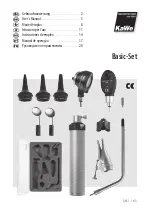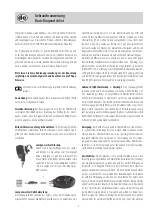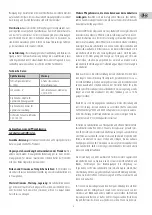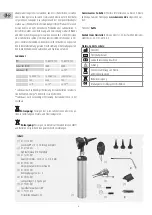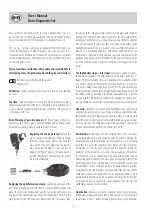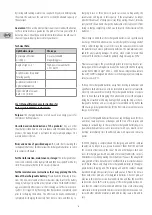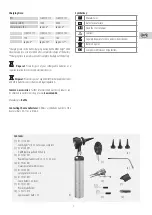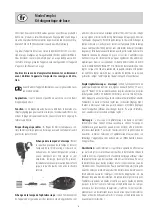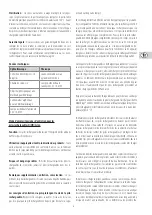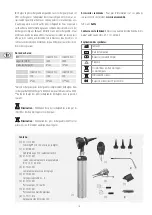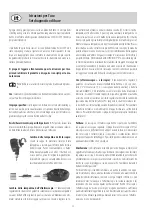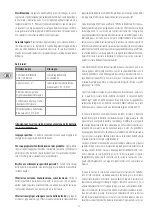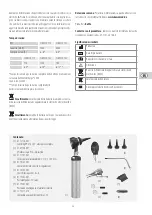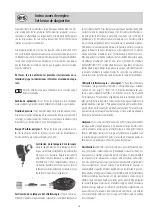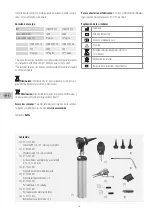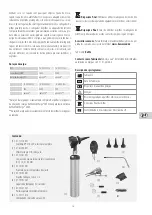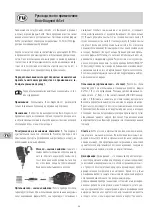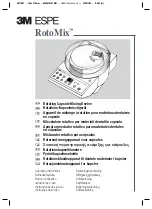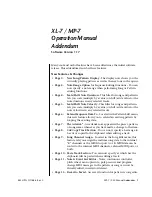
6
by rinsing with running water or in a soap bath. Dry objects before placing
them into the autoclave. Be sure not to exceed the allowed capacity of
the autoclave.
Guarantee:
When used under normal circumstances and with attention
to these instructions we guarantee this product for two years after the
date of purchase. Should you need further information or should your in-
strument require repair, please contact your dealer
Technical Data:
Ophthalmoscope
Otoscope
Ametropia correction:
± 20 dpt..
3-way extendable
magnifying glass
Angle of sight: ± 6°
High-power vacuum bulbs:
2.5V / 0.81W
Aspherical lens for optimal
focusing quality
Aspherical condenser for
optimal illumination
Light strength of vacuum
bulb: 2.5V / 0.81W
User’s Manual/Maintenance Instructions for
Rechargeable NiMH/Li-Ion Batteries
Purpose:
The charging batteries are to be used as an energy source for
the relevant KaWe products.
Unsuited use/contraindication of the products:
Any use other
than that described here is not in accordance with the intended use of this
product. The manufacturer is not liable for any resulting damages. The
user alone bears the risk.
Risks and notice of possible danger: 1.
Avoid short-circuiting the
rechargeable batteries.
2.
Never allow the rechargeable batteries to come
into contact with liquids.
Further information, maintenance, storage:
The rechargeable bat-
teries can be cleaned with a damp cloth and then be wiped off with a dry
cloth. Please ensure that no short-circuit is produced.
Further maintenance instructions that may prolong the life-
time of the rechargeable battery:
Please heed the following instruc-
tions: The non-observance of these instructions may result in the battery
losing its full capacity within a short period of time. With NiMH technol-
ogy, a lazy battery effect can occur that is analogous to the classic memo-
ry effect. It is triggered by the energy that has not been completely spent
prior to recharging the battery. This effect can be nearly eliminated by
completely discharging the battery from time to time and then by re-
charging it two or three times in quick succession. Subsequently, the
accumulator will regain its full capacity. If the accumulator no longer
provides the amount of energy necessary for powering the unit, immedi-
ately turn off the unit and charge the battery (in order to prevent it from
losing its charge completely, which would result in the destruction of the
battery).
Please keep in mind that the rechargeable batteries can spontaneously
discharge. When the batteries are not used (charged) for a long period of
time, a self discharge may occur. In this case, the capacity will be lost and
the batteries may become permanently defective. The manufacturer is not
liable for any resulting damages. Therefore, when stored for more than
one month, the batteries should be partially charged to approx. 50%.
Please always respect the given charging time in order to prevent over-
charging and the resulting destruction of the battery (the KaWe charging
station KaWe Med-Charge® 3000 + 4000 has an integrated automatic
shut-off). NiMH rechargeable batteries lose their capacity at low tempera-
tures (as low as 0°C).
1.
Keep the rechargeable batteries away from heating installations and
open flame.
2.
Batteries are not to be immersed in water or salt water
3.
Never try to disassemble or modify the rechargeable batteries or expose
them to heat.
4.
Avoid dropping the batteries and protect them against
being hit or crushed as this may damage the housing.
5.
Only use the re-
chargeable batteries and accessory parts recommended by KaWe.
6.
When using a rechargeable battery for the first time, please make sure to
charge it completely.
The use of rechargeable batteries that are not explicitly approved for these
units may cause explosions or leakages and the risk of fire, injuries and
damage to surroundings. In the case that a rechargeable battery begins to
leak and spilled substances come into contact with eyes, mouth, skin or
clothing, immediately rinse the affected area with water and consult a
doctor.
1.
When charging is completed and the charging unit and the compact
adapter are no longer in use, please disconnect them from the unit and
the socket in order to avoid the risk of fire and other dangers.
2.
Do not
cover the charging unit with any kind of material (tablecloths, carpets,
bedclothes etc.) while operating the instrument. If you use the adapter for
a long period of time, it may become overheated, lose its original shape or
catch fire.
3.
Please only charge the rechargeable batteries in the appro-
priate battery charging unit. The charging unit and the compact adapter
have been designed especially for use with your unit. Please do not use
them with other products or rechargeable batteries. All other products
may cause the risk of excessive heat and distortion and thus the risk of fire
and electric shock.
4.
Prior to disposing of the rechargeable battery, en-
sure that the contacts are masked with adhesive strips or other insulating
material in order to prevent their direct contact with other materials. Con-
tact with other metallic material in rubbish bins may cause a fire and in-
jury.
Summary of Contents for Basic-Set
Page 23: ...23...

